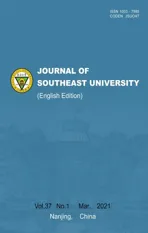Coupling dimensions of human resource archetypes and organizational learning modes
2021-04-24MaLiangZhangShuminZhongWeijun
Ma Liang Zhang Shumin Zhong Weijun
(1School of Economics and Management, Lanzhou University of Technology, Lanzhou 730050, China)(2School of Economics and Management, Southeast University, Nanjing 211189, China)
Abstract:In order to provide channels of human resource management in promoting organizational learning, structural equation models were used for identifying the differences in the coupling dimensions between human resource archetypes and organizational learning modes based on sample data of 219 manufacturing firms with more than 100 employees. It is found that the coupling of the cooperative human resource archetype and exploitative learning is reflected in the mechanistic structure dimension; the coupling of the cooperative human resource archetype and exploratory learning is reflected in the two dimensions of the mechanistic structure and specialist cognition; the coupling of the entrepreneurial human resource archetype and exploitative learning is reflected in the two dimensions of generalist cognition and cognitive trust; the coupling of the entrepreneurial human resource archetype and exploratory learning is reflected in the dimension of generalist cognition. When manufacturing firms pursue exploitative learning, it is suggested that they pay attention to the structure dimension management of the collaborative human resource archetype and the cognition and affect dimensions management of the entrepreneurial human resource archetype. When manufacturing firms pursue exploratory learning, it is suggested pay attention to the structure and cognition dimensions management of the collaborative human resource archetype and the cognition dimension management of the entrepreneurial human resource archetype.
Key words:human resource archetype; organizational learning mode; coupling dimensions; ambidexterity; manufacturing firm
At present, Chinese manufacturing firms are in a critical transformation period from a technology-driven mode to an innovation- and intelligent-driven mode. In order to remove the dilemma of “order-driven production inertia”, improve innovation ability and realize intelligent manufacturing transformation and upgrading, how to use human resources to improve the firm’s learning ability and creativity is the crux of the matter[1].To make human resources become a firm’s core element of transformation, upgrading and innovation, it should first transform into a learning organization, and then give opportunity to the subjective initiative effect of its “people”[2].
Since the organizational learning theory was proposed, the discussion concerning whether learning is dualistic or ambidextrous has never ceased[3-4]. Among them, exploratory learning aims to create new customer value by learning knowledge that is not available in the current organization or group, and it is a radical discontinuous learning process, which can improve the knowledge store at a high speed, high cost and high risk, and acquire small, unstable and novel knowledge[5]. Exploitative learning aims to expand or enrich the current customer value by refining and deepening the organizational or groups’ existing knowledge, and it is a gradual and continuous learning process, which can improve the knowledge store at a low speed, low cost and low risk, and acquire large, stable and obsolete quality knowledge[4].
Accordingly, based on the dualistic view of organizational learning scholars, strategic human resource management scholars first put forward a dualistic configuration of human resources, which divided the human resource configuration into two opposite archetypes: Entrepreneurial and collaborative[6]. Afterwards, strategic human resource management scholars put forward an ambidexterity configuration of human resources in terms of the ambidexterity view of organizational learning scholars, which deduced two interlaced archetypes: Refined interpolation and disciplined extrapolation[7]. It is not difficult to find that the coupling between human resource archetypes and organizational learning modes not only presents in the overall form, but also in the different composition dimensions of human resource archetypes[8].
The human resource archetypes’ dimension view was first proposed by Lepak et al.[9], while they analyzed the differentiated combination of human resource capital attribute and employment relationship under different employment modes based on the knowledge store perspective[10]. The entrepreneurial human resources archetype is composed of the organic structure, generalist cognition and cognitive trust, so it is suitable for the organization implementing exploratory learning[6]. The cooperative human resources archetype is composed of the mechanistic structure, specialist cognition and affective trust, so it is suitable for the organization implementing exploitative learning[11]. In order to cope with the external dynamic market competition, firms must maintain a certain flexibility in production and innovation[12]. In this case, the interface of human resource archetypes and organizational learning modes may not show strict binary matching, but loosely ambidexterity coupling[10].
As a special active resource, although employees have dual control rights to their cognition and affection when they create value for their firm[13], they cannot “break away” from the platform and channel constraints provided by the organizational structure[14]. Therefore, the cognition dimension and affect dimension can play mediating roles between the structural dimension and the organizational learning mode[7, 13,15].
In order to examine whether the coupling dimensions between human resource archetypes and organizational learning modes show differences in Chinese manufacturing firms, this paper empirically tested the significance of the coupling dimension(s) between different human resource archetypes and organizational learning modes. We found that no matter what learning modes are chosen by Chinese manufacturing firms, all different human resource archetypes can all keep coupling with organizational learning modes in specific dimension(s). Therefore, this paper proves that when living in a dynamic competitive environment, the coupling forms between human resource archetypes and organizational learning modes do not exhibit an alternative view that is advocated by dualism scholars, but a flexible and variable view that is advocated by ambidexterity scholars. In addition, this paper clearly reveals what the specific structure, affect, and cognition dimensions are, when different human resource archetypes are coupled with different learning modes. These research results can be used to guide Chinese manufacturing firms how to focus on the specific management dimensions of human resource archetypes in order to improve organizational learning efficacy and competitiveness.
1 Method
1.1 Data and distributive characteristics
In this paper, data was obtained by the sample means of a questionnaire survey conducted from May to December 2017. The survey respondents were taken from large and medium-sized manufacturing firms with more than 100 employees from Tianjin’s greater than 30 industrial parks. Nearly 1 500 firms were visited, from which 293 firms were successfully surveyed. The visiting rate is only 20%, and the lower successful visit rate is because most surveyed firms’ security guards refuse us to enter firm’s factory area. After eliminating 74 questionnaires which were not completed or did not meet the scale of 100 employees, a total of 219 effective questionnaires were obtained, and the efficiency of the questionnaire was 74.7%. The sample firms’ size, establishment time, ownership, and distribution characteristics are shown in Tab.1.
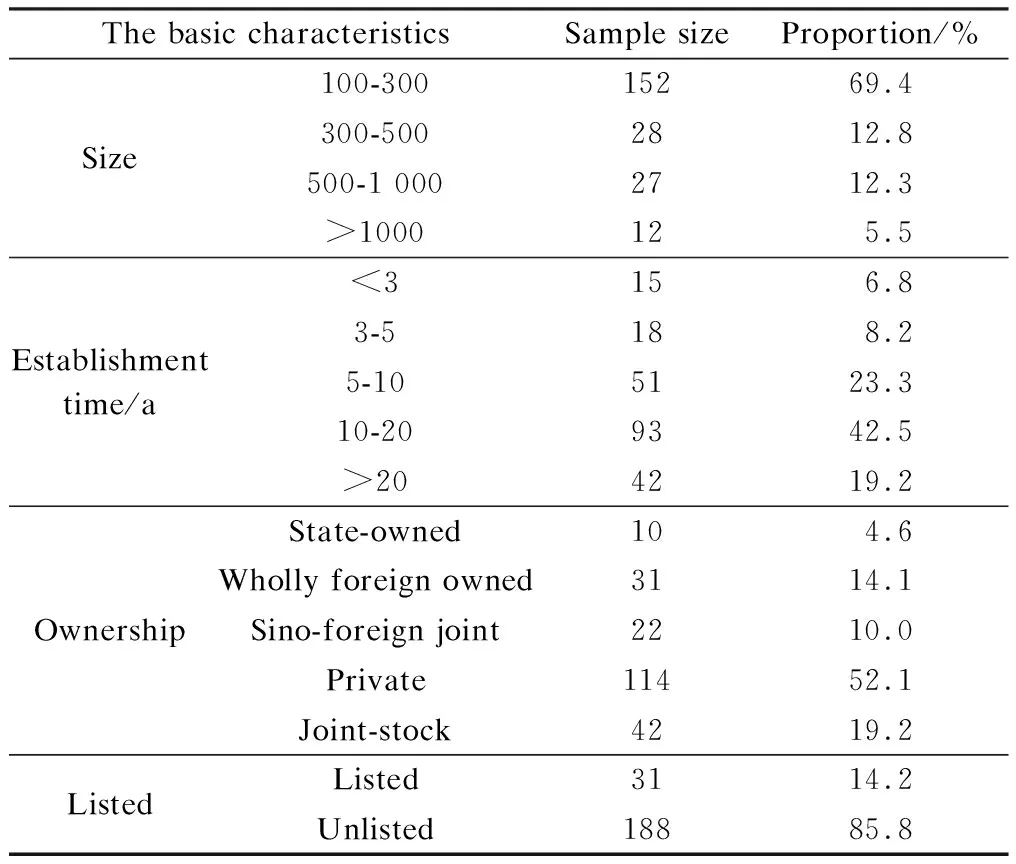
Tab.1 Data distributive characteristics
1.2 Measurement of constructs
This study used existing scales from the literature, and appropriate improvements were made to the scales. Firms’ human resource department managers, strategic department managers and general managers were asked to complete the total questionnaire, and execute 5-point Likert scale style.
The mechanistic structure scale and organic structure scales were designed based on the flexible HRM system scale developed by Chang et al.[16], including a total of 11 items. The mechanistic structure includes six items, such as “with the purpose of quickly and effectively deploying and using these core employees, our company pays attention to the use of human resources information system to keep and update the information of core employees in a timely manner”. The organic structure consists of 5 items, such as “the skills training courses provided by our company for core employees acquiring diversified skills may not be directly related to their current jobs”.
The generalist cognition scale and specialist cognition scales were designed based on the knowledge value and specialty scale developed by Lopez-Cabrales[17], including 9 items. The generalist cognition scale includes 5 items, such as “our employees have the skills to develop new products/new markets/new services”. The specialist cognition scale consists of 4 items, such as “our employees have skills that our competitors don’t have, and our employees have skills that have been acquired through their current job experience”.
The cognitive trust scale and affective trust scales were designed according to the cognition-based trust and affect-based trust scale developed by McAllister[18], including 11 items. The cognitive trust scale consists of 6 items, such as “our employees have a good performance history, so their competence and work attitude will not be doubted”. There are 5 items in the affective trust scale, such as “there is a shared relationship between our employees, who can freely share each other’s creativity, emotions and expectations”.
The exploitative learning and exploratory learning scales were designed based on the same scales developed by Kang et al.[8], including 12 items. The exploitative learning scale includes 6 items, such as “our company focuses on in-depth research and development on the basis of existing products or services, and then introduces new products or services to the market”. The exploratory learning scale includes 6 items, such as “our company has always maintained a leading technology position when solving customers’ product needs, and our company can quickly identify new customer markets by transforming product R & D capabilities and knowledge foundation in a timely manner”.
1.3 Constructs reliability test
In order to verify whether the sample data can be used to test the theoretical framework,an exploratory factor analysis should be carried out to discover whether the structural characteristics of the sample data are consistent with the theoretical constructs. In this paper, SPSS 26.0 software was used for the exploratory factor analysis. After several attempts, the final exploratory factor analysis results are obtained after deleting unreasonable items, which are shown in Tab.2.
The KMO value of the 8 constructs was 0.907, and thePvalue of Bartlett’s spherical test was close to 0, indicating that there was a strong correlation between the construction items, which was suitable for the factor analysis. According to the principle that the eigenvector value is greater than 1, 8 factors were selected, with the contribution rate of cumulative variance reaching 66.304%, and the extraction value of each item being above 0.5.
The Cronbach’sαreliability coefficients of the overall scale, organizational learning scales, structure scales, affect scales and cognition scales were 0.946, 0.843, 0.868, 0.889 and 0.902, respectively (see Tab.2). The coefficient values are above 0.7, indicating that all constructs scales have a higher internal consistency reliability. The variance contribution rate of the first principal component is used to measure the structural validity of constructs scales. As can be seen from Tab.2, the variance contribution rate of the first principal component of each construct scale is above 50%, indicating that the scales in this paper have a high structural validity.
AMOS 26.0 software was used to further test the discriminative validity among constructs based on the confirmatory factor analysis (CFA) technique. The indices of the fitting degree of the AMOS models are shown in Tab.3. Firstly, the CFA analysis was carried out on the 8 constructs without any merging treatment. Secondly, the dualistic forms of 8 constructs were combined into a monadic form to construct 4 factors including structure, cognition, affect and learning. Thirdly, the structure, cognition and affect dimensions of the human resource archetypes were combined, and the CFA results are shown in a 2-factor model. Finally, all 8 constructs were integrated into a 1-factor model. It can be seen from Tab.3 that the 8-factor model has the best fitting degree compared with other models, indicating that the 8 constructs have better discriminant validity. Among the fitting indices of the 8-factor model, except for the GFI index which does not reach the 0.9 standard, all other indices are above 0.9[19], and the RMSEA and SRMR are both below 0.07, so the 8-factor model can be regarded as a better fit.
The questionnaire is mainly completed by the human resources department, the strategy department and the general manager. This self-evaluation questionnaire may have the problem of common method biases. To avoid these, we did the Harman single factor test, and found that there is not one common factor that can explain most of the data variation (the first principal component contribution rate is only 33.77%). Meanwhile,according to Refs.[20-21], we used the method of “controlling for the effects of an unmeasured latent method factor” to examine the common method biases. The results show that the differences between the two-factor model and the model only containing specific factors were not significant. In addition, each variable was loaded on the specific factor. When surveying, each firm only completed one questionnaire and the investigation purpose and intention were clearly explained to the respondents, asking them to answer the items according to the objective reality. In conclusion, the common method bias from our sample data did not cause a major concern in this study.
2 Estimation Results of SEMs
We controlled firms’ size (measured by the total number of their employees), age (years since the firm opened its business) and listing (whether they were publicly listed) that may affect organizational learning.
The data’s descriptive statistical analysis results are shown in Tab.4. As can be seen from Tab.4, there is a significant correlation between the organic structure and the mechanistic structure, and all the relationships between the two constructs and other constructs are all robust and prominent. This indicates possible coupling between two human resource archetypes and two organizational learning modes.
This paper constructed 4 structure equation models to test the coupling dimension(s) between two archetypes and two organizational learning modes.
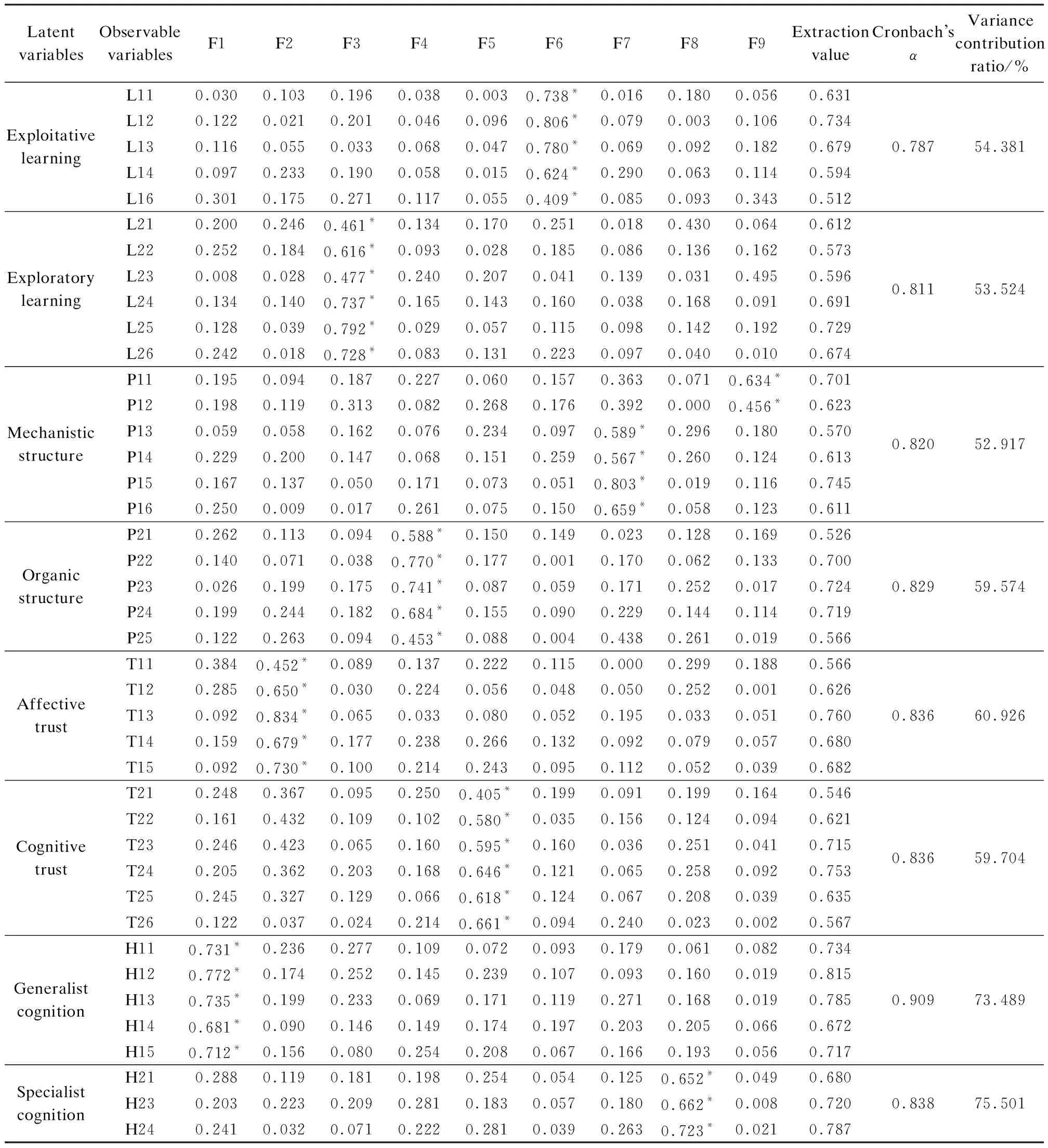
Tab.2 Exploratory factor analysis

Tab.3 CFA test

Tab.4 Descriptive statistical analysis
Considering that the structural equation model is different from general OLS regression analysis, control variables are added to the structural equation model. The estimated parameters will increase, and the performance of fit indices will decrease. In order to improve the excellent fit performance, control variables are not included in the four structural equation models. Nonetheless, we constructed four SEMs including control variables, and the regression results show that the path coefficients have no significant difference from the SEMs not including the control variables. Therefore, this paper only presents four SEMs not including the control variables.
In this paper, AMOS 26.0 software is used to compute the path coefficients of the four SEMs by the maximum likelihood estimation methods. When testing the indirect effects between latent variables, a Monte Carlo method is executed iteratively 20 000 times by setting 10 random number seed, in which the bias-corrected percentile Bootstrap method is used to examine the variables’ mediating roles[22].
Structural equation model 1 was constructed to test the prominent dimensions between the three dimensions of cooperative human resource archetype and the exploitative learning mode. The path coefficients of the structural equation model are shown in Fig.1, and the fit index is shown in Tab.5. The model’s GFI, AGFI, NFI, and CFI are all close to or greater than 0.9[19], and RMSEA and SRMR are both below 0.07. Therefore, AMOS model 1 can be considered as a better fit.
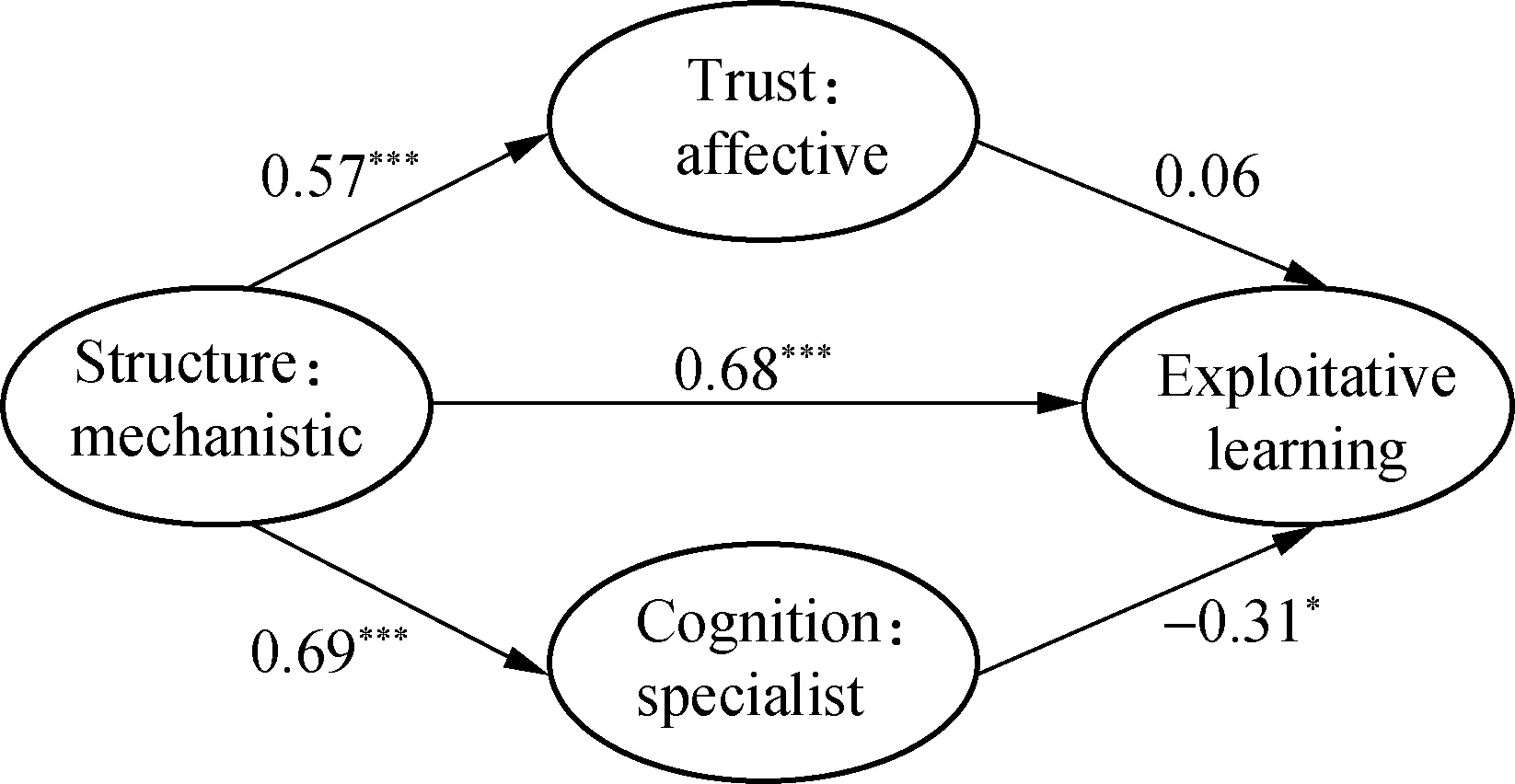
Fig.1 Structural equation model 1

Tab.5 Indicator fitness of AMOS models
As can be seen from Fig.1, the direct effect coefficient of the mechanistic structure on exploitative learning is positive and significant (β=0.68,p<0.001), indicating that the mechanistic structure can directly promote organizational exploitative learning. The direct effect coefficient of affective trust on exploitative learning is not significant (β=0.06,p>0.1), indicating that affective trust cannot directly influence organizational exploitative learning. The direct effect coefficient of specialist cognition on exploitative learning is negative and significant (β=-0.31,p<0.05), indicating that the specialist cognition exerts an inhibitory effect on the organizational exploitative learning. From Tab.6, it can be seen that the indirect effects of the mechanistic structure on exploitative learning through affective trust and specialist cognition are not significant (coefficient is -0.180, bias corrected CI=[-0.468, 0.049]), and bias corrected CI contains zero indicating that the two co-mediating effect were not significant. Combined with the significant total effect of the mechanistic structure on exploitative learning (coefficient is 0.504, bias corrected CI=[0.353, 0.667]), we found that the mechanism of the cooperative human resource archetype promoting organizational exploitative learning is the mechanistic structure directly affecting organizational exploitative learning.

Tab.6 Bootstrap analysis of the double mediation effect test
Structural equation model 2 was constructed to test the prominent dimensions between the three dimensions of the cooperative human resource archetype and the exploratory learning mode. The path coefficients of the structural equation model are shown in Fig.2, and the fit index is shown in Tab.5. The model’s GFI, AGFI, NFI, and CFI are all close to or greater than 0.9[19], and the RMSEA and SRMR are both below 0.07. Therefore, AMOS model 2 can be regarded as a better fit.
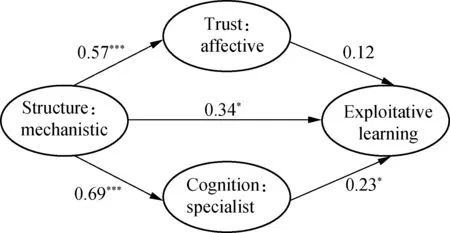
Fig.2 Structural equation model 2
As can be seen from Fig.2, the direct effect coefficient of the mechanistic structure on exploratory learning is positive and significant (β=0.34,p<0.05), indicating that the mechanistic structure can directly promote organizational exploratory learning. The direct effect coefficient of affective trust on exploratory learning is not significant (β=0.12,p>0.1), indicating that affective trust cannot directly influence organizational exploratory learning. The direct effect coefficient of specialist cognition on exploratory learning is positive and significant (β=0.23,p<0.05), indicating that the specialist cognition exerts a promoting effect on the organizational exploratory learning. From Tab.6, it can be seen that the indirect effects of the mechanistic structure on exploratory learning through affective trust and specialist cognition are not significant (coefficient is 0.227, bias corrected CI=[-0.036, 0.502]), and bias corrected CI contains zero indicating that the two co-mediating effects were not significant. Combined with the significant total effect of the mechanistic structure on exploratory learning (coefficient is 0.564, bias corrected CI=[0.387, 0.724]), we found that the mechanism of cooperative human resource archetype promoting organizational exploratory learning has two paths, namely, the mechanistic structure directly affecting organizational exploratory learning and indirectly affecting through specialist cognition.
Structural equation model 3 was constructed to test the prominent dimensions between the three dimensions of entrepreneurial human resource archetype and the exploitative learning mode. The path coefficients of the structural equation model are shown in Fig.3, and the fit index is shown in Tab.5. The model’s GFI, AGFI, NFI, and CFI are all close to or greater than 0.9[19], and RMSEA and SRMR are both below 0.07. Therefore, AMOS model 3 can be considered as a better fit.
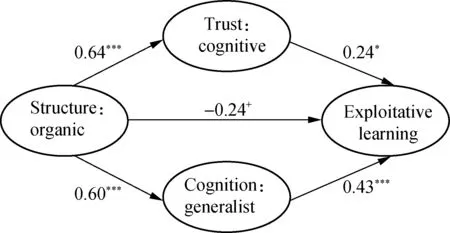
Fig.3 Structural equation model 3
As can be seen from Fig.3, the direct effect coefficient of the organic structure on exploitative learning is negative and weakly significant (β=-0.24,p<0.1), indicating that the organic structure can inhibit organizational exploitative learning. The direct effect coefficient of cognitive trust on exploitative learning is positive and significant (β=0.24,p<0.05), indicating that cognitive trust can directly promote organizational exploitative learning. The direct effect coefficient of generalist cognition on exploitative learning is positive and significant (β=0.43,p<0.001), indicating that the generalist cognition exerts a promotional role on organizational exploitative learning. From Tab.6, it can be seen that the indirect effects of the organic structure on exploitative learning through cognitive trust and generalist cognition are significant (coefficient is 0.411, bias corrected CI=[0.240, 0.638]), and the bias corrected CI does not contain zero, indicating that the two co-mediating effects were significant. Combined with the significant total effect of the organic structure on exploitative learning (coefficient is 0.170, bias corrected CI=[0.320, 0.569]), we found that the mechanism of the entrepreneurial human resource archetype promoting organizational exploitative learning is indirectly realized, and the paths include cognitive trust and generalist cognition simultaneously.
Structural equation model 4 was constructed to test the prominent dimensions between the three dimensions of the entrepreneurial human resource archetype and the exploratory learning mode. The path coefficients of the structural equation model are shown in Fig.4, and the fit index is shown in Tab.5. The model’s GFI, AGFI, NFI, and CFI are all close to or greater than 0.9[19], and RMSEA and SRMR are both below 0.07. So, AMOS model 3 can be regarded as a better fit.
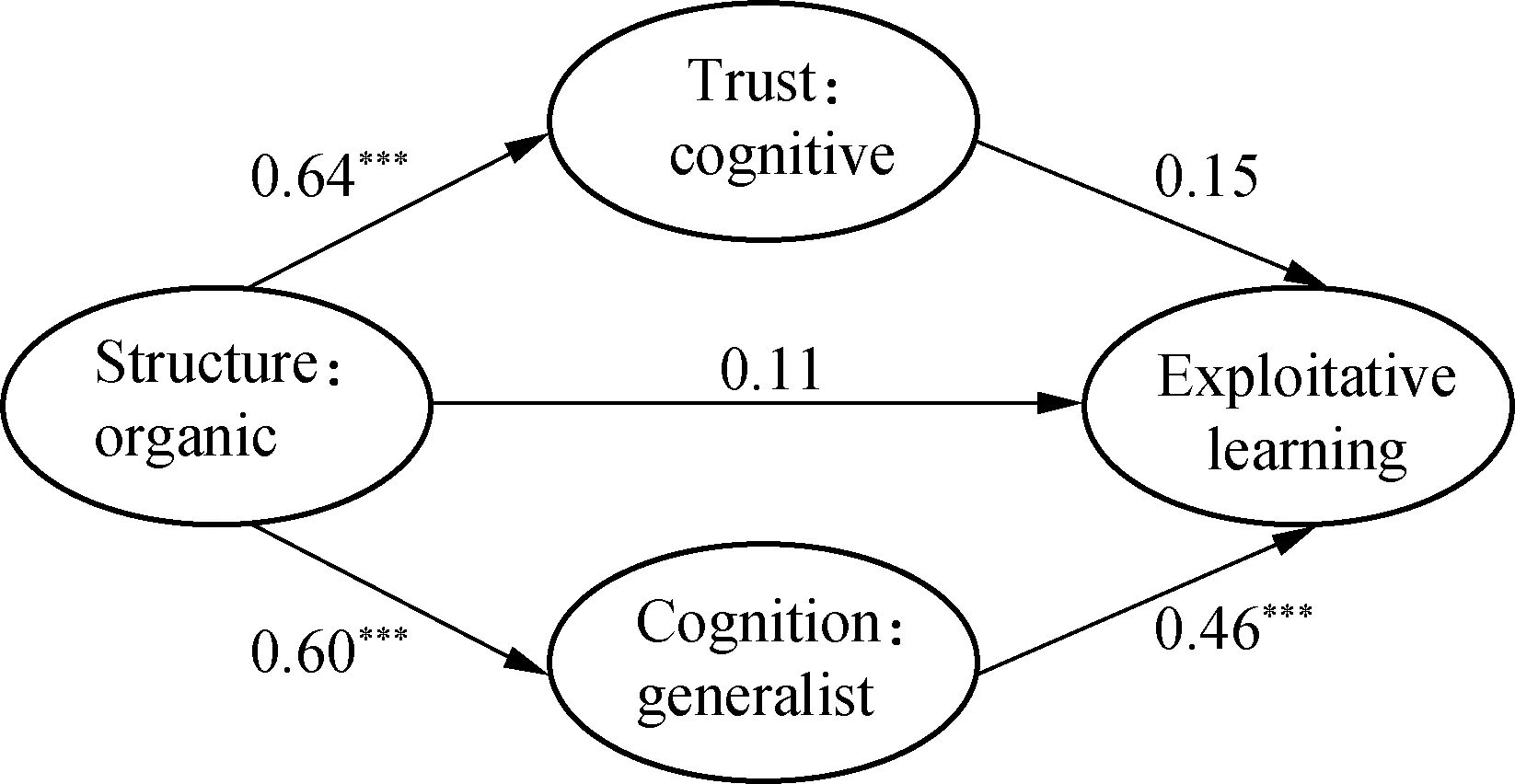
Fig.4 Structural equation model 4
As can be seen from Fig.4, the direct effect coefficient of the organic structure on exploratory learning is not significant (β=0.11,p>0.1), indicating that the organic structure cannot directly promote organizational exploratory learning. The direct effect coefficient of cognitive trust on exploratory learning is not significant (β=0.15,p>0.1), indicating that cognitive trust cannot directly promote organizational exploratory learning. The direct effect of generalist cognition on exploratory learning is positive and significant (β=0.46,p<0.001), indicating that the generalist cognition exerts a promoting role on the organizational exploratory learning. From Tab.6, it can be seen that the indirect effects of the organic structure on exploratory learning through cognitive trust and generalist cognition are significant (coefficient is 0.374, bias corrected CI=[0.182, 0.581]), and bias corrected CI does not contain zero, indicating that the two co-mediating effects were significant. Combined with the significant total effect of the organic structure on exploratory learning (coefficient is 0.486, bias corrected CI=[0.340, 0.620]), we found that the mechanism of entrepreneurial human resource archetype promoting organizational exploratory learning has two indirect paths. One path is the main one and realized through generalist cognition and the other path is non-main and realized through cognitive trust.
3 Theoretical and Practical Discussion
3.1 Coupling of the cooperative human resource archetype and exploitative learning
For manufacturing firms,cooperative human resource archetype can promote organizational exploitative learning only by the dimension of the mechanistic structure. Meanwhile, specialist cognition plays a certain negative mediating role between the mechanistic structure and exploitative learning.
It is known by the knowledge management theory and social exchange theory that the mechanistic structure can encourage members in an organization to share and exchange their knowledge, skills, experience and opinions to each other, which accelerates the flow of knowledge and information within the organization. This indicates that the mechanistic structure can help an organization to continuously learn, absorb and transform knowledge and information, and most of the knowledge and information is homogeneous and familiar. Therefore, under the circumstances, organizational exploitative learning can be promoted very effectively. In addition, the mechanistic structure can also promote members’ affective trust and specialist cognition. Based on the social networks theory, we can know that the members’ affective trust established by the mechanistic structure can provide certain emotional support for organizational exploitative learning. However, due to the strong connection of the repetitive and redundant social networks, it is difficult to achieve a significant exploitative learning effect. Cognition involves inertia, thus enabling specialist cognition’s diversity insufficient, which in turn restricts the organizational exploitative learning.
In practice, if manufacturing firms want to adopt and carry out an exploitative learning mode, the management emphasis of cooperative human resource archetype should be placed on the mechanistic organization structure’s dimension. At this point, the mechanistic structure can not only accelerate the speed of translating, exchanging and integrating members’ familiar and unfamiliar knowledge and information, but also can increase the probability of successful exploitative learning. However, if firms put management emphasis on the two dimensions of affective trust and specialist cognition, the organizational exploitative learning will not be promoted, and can even be inhibited. For example, once firms put more emphasis on member’s specialist cognition management in their exploitative learning, although the cognition depth is increased, the cognition diversity is limited, which wastes resources, time and opportunities, and then exploitative learning will be inhibited.
3.2 Coupling of cooperative human resource archetype and exploratory learning
For manufacturing firms, the cooperative human resource archetype can promote organizational exploratory learning by two dimensions of mechanistic structural and specialist cognition. Meanwhile, specialist cognition plays a positive mediating role between the mechanistic structure and organizational exploratory learning.
It is known by the social support and trust theory that the mechanistic structure can provide opportunities for members to tolerate, support and trust novel knowledge, viewpoints and ideas, which guarantees the exploratory learning journey being successfully completed. Organizations pursuing exploratory learning are eager to acquire more novel and breakthrough knowledge, skills and viewpoints. However, exploratory learning brings greater risks and greater instability to organizations. Therefore, the mechanistic structure can provide communication opportunities for members to eliminate worry, doubt and distrust in the exploratory learning process. In addition, the mechanistic structure encourages members to translate, share and exchange novel knowledge, skills, experience, and opinions, which can improve organizational cognition specificity. Because specialist cognition is deeply embedded in an organization, it has high stability and low vulnerability and is usually controlled by senior employees in the organization. Therefore, when the organization makes significant discontinuous changes, such as emphasizing exploratory learning, although specialist cognition is homogeneous and has a low diversity of knowledge and ideas, specialized and stable characteristics just are what exploratory learning needs.
In practice, if manufacturing firms want to adopt and carry out an exploratory learning mode, the management emphasis of cooperative human resource archetype should be placed on the mechanistic structure dimension and specialist cognition dimension. At this point, the mechanistic structure provides a supportive, trusting and persistent platform for members to translate, share and exchange novel knowledge, opinions and ideas. Meanwhile, although specialist cognition indicates that members’ knowledge and ideas have a low diversity, it also indicates a high specialty that determines the correctness and validity of organizational exploratory learning. Compared with the organizational exploitative learning analysis results, it can be found that the mechanistic structure can both promote organizational exploitative and exploratory learning, but affective trust can promote neither. In addition, specialist cognition can promote organizational exploratory learning, but cannot promote organizational exploitative learning, which is an interesting finding and deserves further study.
3.3 Coupling of entrepreneurial human resource archetype and exploitative learning
For manufacturing firms, entrepreneurial human resources archetype can promote organizational exploitative learning by the two dimensions of cognitive trust and generalist cognition. Meanwhile, the organic structure has a direct negative effect on organizational exploitative learning.
It is known from human capital theory that the organic structure can help organizations reserve, develop and allocate dissimilar knowledge, skills, experience, and viewpoints, thereby greatly enriching the heterogeneity of organizational human capital “pool”[23]. Also, the innovation diversity theory indicates when the organic structure creates too much diversity, viewpoint conflicts will inevitably arise in the organization, especially when conflict costs are beyond the innovative benefits of the diversity. Accordingly, the organic structure can have an adverse impact on organizational exploitative learning. However, although the organic structure itself is not good for organizational exploitative learning, the organic structure can both improve cognitive trust and cognition diversity, and then promote organizational exploitative learning. By the human capital resource management theory, we know that cognitive trust and generalist cognition can guarantee members’ up-to-date knowledge and ideas being timely and rapidly provided in the organizational exploitative learning process. The identity theory asserts that if organizational members have a higher cognition trust, their knowledge and perspectives can be smoothly translated, exchanged and absorbed, especially when the knowledge and perspective have some similar and common characteristics. Therefore, given the novelty limitation of cognition trust, it may not promote organizational exploratory learning. We know that when organizations pursue exploratory or exploitative innovation, many universal and diversified cognition resources are needed. Therefore, the generalist cognition can both promote organizational exploitative learning and exploratory learning.
In practice, if manufacturing firms want to adopt and carry out an exploitative learning mode, the management emphasis on the entrepreneurial human resource archetype should be put on the two dimensions of cognitive trust and generalist cognition. At this point, cognitive trust guarantees members’ knowledge, skills, perspective and ideas being smoothly translated, exchanged and shared, and generalist cognition guarantees that the trusted cognition resources have adequate diversity and breadth. Although the organic structure dimension cannot be directly managed for promoting organizational exploitative learning, it can first be used for improving cognitive trust and generalist cognition, and it can then facilitate organizational exploitive learning. Therefore, firms can also put management emphasis on the organic structure.
3.4 Coupling between entrepreneurial human resources archetype and exploratory learning
For manufacturing firms, the entrepreneurial human resource archetype can promote organizational exploratory learning only by the generalist cognition dimension. Although the organic structure can directly affect cognitive trust, the effect of cognitive trust on exploratory learning is not significant. This also indicates that the organic structure can affect organizational exploratory learning only by the indirect path of generalist cognition. Meanwhile, the organic structure has no significant positive direct effect on the organizational exploitative learning.
It is known by the innovative diversity theory and the punctuated equilibrium theory that the organic structure can help organizations to access adequate and discontinuous diverse knowledge, perspectives and ideas, which in turn will promote organizational exploratory learning. However, the organic structure dimension is not directly driving organizational exploratory learning, only by the indirect means of improving organizational generalist cognition. Firstly, by the conflict adaptation theory[24], we know that the organic structure may cause conflict in members’ cognition, but the adjustment of cognitive control can increase members’ cognitive trust in each other. Secondly, by the cross-border learning theory, we know that the organic structure can provide many opportunities for members to learn new knowledge, skills and perspectives, which will increase members’ generalist cognition in turn. Therefore, the organic structure can provide platform support for organizations to implement exploratory learning to enrich the diversity of knowledge, skills, experience and viewpoints, and thus, satisfy the need for discontinuity and abrupt knowledge in the exploratory learning process. When organizations pursue exploratory learning, plenty of novel and diversified cognitive resources are necessary. However, in contrast to exploitative learning, cognitive trust is not necessary in organizations’ exploratory learning processes.
In practice, if manufacturing firms want to adopt and carry out an exploratory learning mode, the management emphasis of the entrepreneurial human resource archetype should be put on generalist cognition, and not on cognition trust. Just as exploitative learning does , generalist cognition can provide plenty of novel and diversified heterogeneous knowledge, skills and perspectives for organizations to pursuit exploratory learning. That is, generalist cognition guarantees the trusted cognition resources having adequate diversity and breadth. However, although cognition trust guarantees organizational members’ knowledge, skill, perspective and ideas being smoothly translated, exchanged and shared, and can promote organizational exploitative learning, it is not necessary for organizational exploratory learning. In addition, the organic structure can first be used for improving cognitive trust, and then for facilitating organizational exploratory learning.
4 Conclusion and Future Directions
The structural equation models and the mediating relationships test are carried out to clarify the specific coupling dimensions between different human resource archetypes and different organizational learning modes. Several valuable conclusions have been drawn. The coupling of the cooperative human resource archetype and exploitative learning is reflected in the mechanistic structure dimension; the coupling of cooperative human resource archetype and exploratory learning is reflected in the two dimensions of the mechanistic structure and specialist cognition; the coupling of the entrepreneurial human resource archetype and exploitative learning is reflected in the two dimensions of generalist cognition and cognitive trust; the coupling of the entrepreneurial human resource archetype and exploratory learning is reflected in the dimension of generalist cognition. This paper not only clarifies the existence of ambidextrous coupling between human resource archetypes and organizational learning modes, but more importantly, clarifies the difference in a specific dimension(s) of the ambidextrous coupling, which provides effective “channels” for firms to promote organizational learning from the view of human resource management.
Although this paper has clarified the difference in the coupling dimension(s) between human resource archetypes and organizational learning modes, there remain three shortcomings in this paper that need to be further studied. First, the theoretical framework of this paper is a static matching paradigm, and future research can reveal the changing rule of coupling dimension(s) between human resource archetypes and organizational learning modes based on longitudinal data. Secondly, although the structural equation model adopted in this paper has advantages in revealing the path relationships between variables, it cannot prove the causal relationship between variables. Future research can use the panel data model to test difference in the the coupling dimension(s) based on longitudinal data. Thirdly, the data in this paper is limited to manufacturing firms, and the research conclusions are limited in relevance. Future research can focus on specific industries in manufacturing firms to study the differences in the particular coupling dimension(s).
杂志排行
Journal of Southeast University(English Edition)的其它文章
- Expansion performance and self-stressing behavior of CFST columns considering concrete creep and shrinkage effect
- Min-max fuzzy model predictive tracking control of boiler-turbine system for ultra-supercritical units
- Firm review revelation policy considering social ties among consumers
- Fundamentals of quasigroup Hopf group-coalgebras
- A fault feature extraction method of gearbox based on compounddictionary noise reduction and optimized Fourier decomposition
- Effect of carbonation-drying-wetting on durability of coral aggregate seawater concrete
